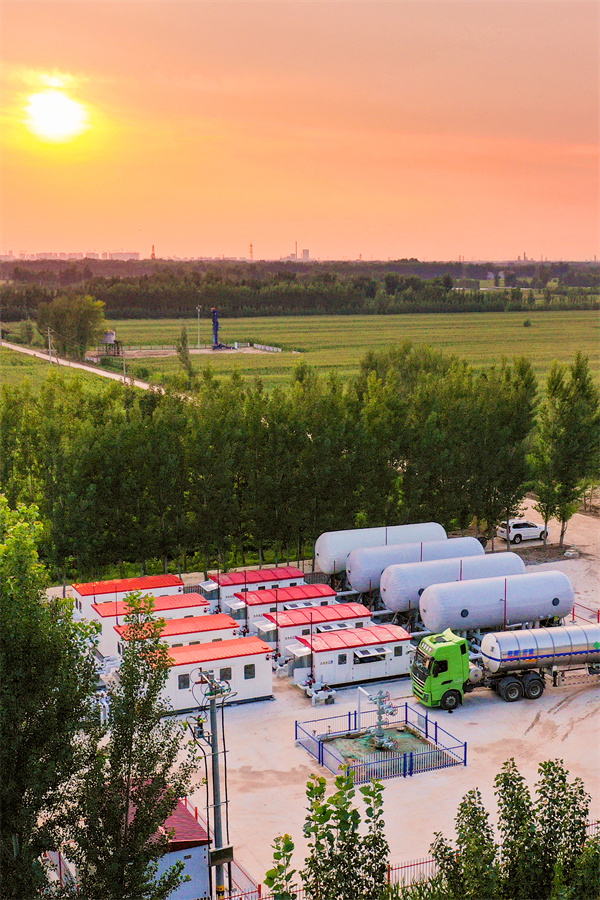Editor's note:
Chinese central state-owned enterprises (SOEs) have been playing a key role in making the sky bluer, the mountains lusher and the water more lucid. On March 12, National Tree Planting Day in China, let's take a look at the energy-conserving and carbon-reduction projects developed by central SOEs.
1. China Electronics Technology Group Corporation

With an installed capacity of about 105.60 megawatts, the Qinghai Golmud 100MW PV Power Plant has an estimated annual average power generation capacity of 191.71 million kilowatt-hours, equaling that by burning 61,384.22 metric tons of standard coal and an equivalent to planting 1.68 million trees.
2. China National Petroleum Corporation

In 2022, the Carbon Capture, Utilization and Storage (CCUS) project of China National Petroleum Corporation was implemented in Jilin, Changqing and other oil fields.
The annual storage of CO2 in the CCUS project exceeds 1 million tons, equivalent to planting nearly 9 million trees.
3. China Petrochemical Corporation

The Megaton CCUS project in Shengli Oilfield, with an annual carbon dioxide emission reduction of 1 million tons, is significant for building "artificial carbon cycle" model. Its capacity of carbon reduction equals planting nearly 9 million trees.
4. China Oil & Gas Pipeline Network Corporation

The pipeline's total mileage of the west-east gas transmission project exceeds 20,000 kilometers. It is the most extensive natural gas pipeline in China.
Since its operation, it has delivered more than 800 billion cubic meters of natural gas, replacing the demands of 1.07 billion tons of standard coal and therefore reducing CO2 emissions by 1.17 billion tons and dust by 580 million tons.
All effects were equivalent to planting 3.6 billion hectares of broadleaf forests.
5. China Huaneng Group Co., Ltd.

The Huaneng Nuozadu Hydropower Station has an installed capacity of 5.85 million kilowatts and has an annual average power generation capacity of 23.912 billion kWh, which, if produced by a coal-fired power plants of similar size, would use 9.56 million tons of standard coal each year.
Therefore the station has reduced carbon dioxide emissions by 18.77 million tons, equivalent to planting 58,000 hectares of forest.
6. China Huadian Cooperation Ltd.

Covering an area of about 20,000 mu (about 1,333 hectares), the Liangzhou Jiuduntan PV power plant has a total installed capacity of 500,000 kilowatts.
The project makes full use of the abundant local solar energy resources to develop the photovoltaic power generation industry.
By growing psammophyte plants below the PV modules, the company develops the sand and grass industry.
The annual power generation capacity of the project can reach 1 billion kWh and more than 20,000 mu of sand can be effectively treated.
It's worth noting that the annual carbon dioxide emission reduction can reach 306,000 tons, saving 123,000 tons of standard coal, equivalent to planting 3,060 hectares of trees per year.
7. State Power Investment Corporation Limited

The Haiyang Nuclear Power Plant is the first nuclear power plant completed and put into operation in East China's Shandong Province. Its annual equivalent of afforestation is about 45,900 hectares.
The annual power generation capacity of units 1 and 2 of the first phase project is about 20 billion kilowatt hours.
Its annual coal consumption can be reduced by about 8.55 million tons compared to coal-fired power plants of the same size, reducing carbon dioxide emissions by about 16 million tons.
Its emission reduction effect is equivalent to planting broadleaf forests of about 44,000 hectares.
The 4.5 million square meter nuclear energy heating project is the largest nuclear energy heating project in China, with annual average heat supply of 860,000 GJ during the heating season.
It can reduce carbon dioxide emissions of about 180,000 tons, equivalent to planting broadleaf forests of about 1,000 hectares.
8. China Energy Investment Corporation

The coal indirect liquefaction demonstration project (four million tons per year) of China Energy Group Ningxia Coal Industry is the world's largest stand-alone coal indirect liquefaction project.
The implementation of dozens of cost-saving and carbon-reducing projects, such as boiler desulfurization and denitrification, pipe network renovation and upgrading, and gasification slag drain upgrading, cut raw coal usage by more than 1.2 million tons, equivalent to planting 246 million trees.
9. China Telecom Corporation Limited

The China Telecom (National) Digital Qinghai Green Big Data Center is the first zero-carbon data center in China.
It realizes 100 percent clean energy supply after full completion and its annual carbon reduction is about 300,000 tons, equivalent to planting 20 million trees.
10. China United Network Communications Group Co., Ltd.

Its distributed energy end communication 5G application project uses 5G power network at the provincial level to access distributed PV and promotes distribution network automation and other services.
It is expected to provide 3.92 GW of clean energy per year and reduce CO2 emissions by approximately 34.24 million tons, which is equivalent to planting 139,000 hectares of forest.